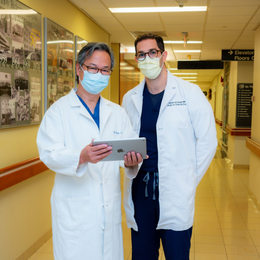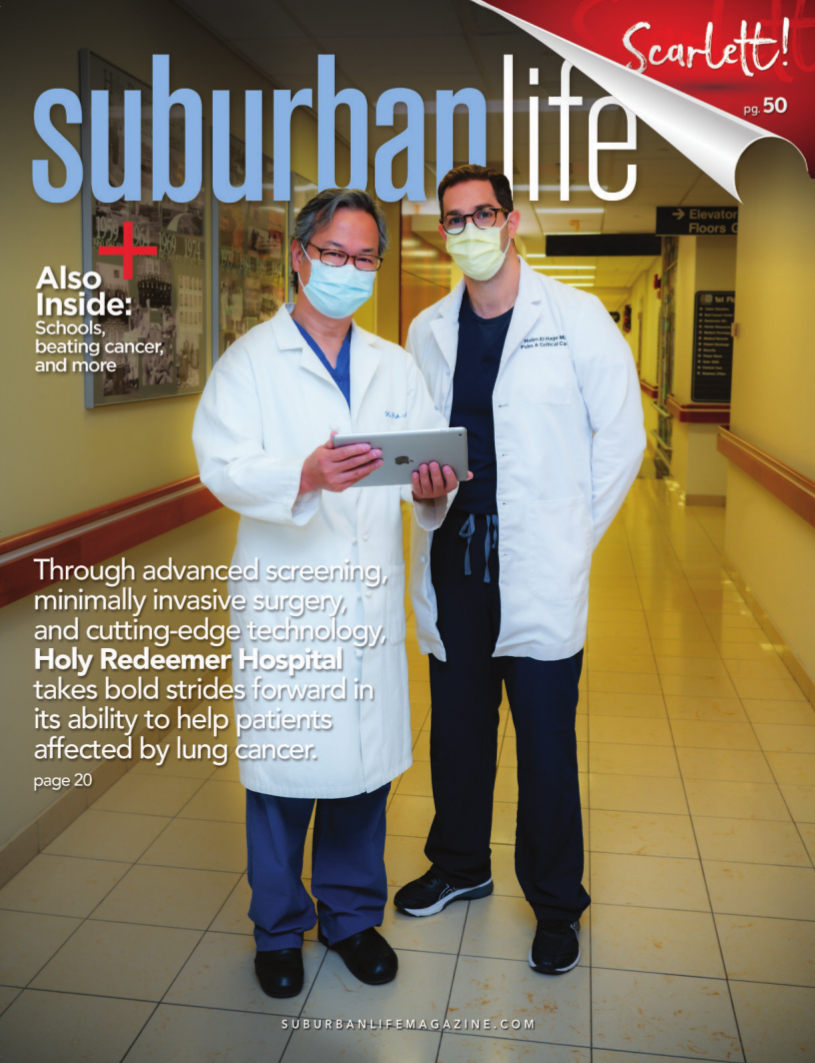
Breathing Easier
Through advanced screening, minimally invasive surgery, and cutting-edge technology, Holy Redeemer Hospital takes bold strides forward in its ability to help patients affected by lung cancer.
Most Americans would likely be surprised to learn that lung cancer is the second most common cancer in both men and women. It’s also by far the leading cause of cancer death among both men and women, according to the Centers for Disease Control and Prevention. However, due to advances in screening, diagnostics, and treatment, lung cancer is now much more manageable.
Anyone considered high risk for developing lung cancer should be screened for the disease. This group includes any individual with a “significant” smoking history of 20 years or more, according to Ho Pak, M.D., the director of surgical oncology services at the Charles A. and Betty Bott Cancer Center at Holy Redeemer Hospital in Meadowbrook.
“People who are 55 to 77 years of age, who are current smokers or former smokers who have quit within the past 15 years and have at least a 30-pack-a-year smoking history should consider being screened,” says Dr. Pak, who did his fellowship in surgical oncology at the National Cancer Institute. “If we find lung cancer early enough, we have a chance to treat it successfully. With advances like our Lung Cancer Screening Program, we hope that there will be more cancer survivors.”
Through this program, Holy Redeemer utilizes a low-dose CT scan (LDCT) to detect lung cancer, even in the earliest stage, thereby increasing a patient’s chances for successful treatment and long-term survival. The screening test, which is covered by Medicare and many insurance providers, may result in three possible outcomes: no further action, for those with a clear scan; a follow-up CT scan, if needed; or, if the screening yields something suspicious, a biopsy.
If “something suspicious” turns out to be cancer, Holy Redeemer employs the expertise of a multidisciplinary team of surgical oncologists, radiation oncologists, pulmonologists, nurse navigators, and other medical professionals. The team members collaborate to determine the best treatment option for each patient.
“Ultimately,” Dr. Pak continues, “our recommendations depend on the outcome of the workup we do, and we work as a group to figure out what will give the patient the best chance for recovery.”
That’s where Halim El Hage, M.D., a pulmonary and critical care physician with Holy Redeemer, comes in. Dr. El Hage often uses a minimally invasive procedure known as an endobronchial ultrasound (EBUS) to diagnose lung cancer, even in areas that were once considered difficult to access.
“EBUS has changed the way we deal with lung cancer,” Dr. El Hage says. “Because of this technology, we can now see beyond the airways, into the lymph nodes, take multiple samples, and accurately stage the cancer. One to two days later [after the EBUS procedure], we can have a full-stage diagnosis.”
He can also perform a navigational bronchoscopy, which combines electromagnetic navigation with real-time computed tomography images to create a three-dimensional “Google Map of the lungs,” as he calls it. The procedure employs special instruments to examine and diagnose lesions in areas of the lungs inaccessible to a regular bronchoscope.
“In the old days, if you had a spot on the lungs in a pesky area, you couldn’t even biopsy it,” he adds. “Now, no matter how tiny or minuscule, you can get to it early on instead of watching it for months and waiting for the cancer to spread.”
Dr. El Hage, who was born in Lebanon, did his fellowship in pulmonary and critical care medicine with Northwell Health in Staten Island, New York. He has been heartened by recent advances in treatment for patients with lung care, including those being made at Holy Redeemer.
Treatment options may include chemotherapy, radiation, and surgery to remove the affected lobe. Depending on the individual patient and the cancer, the multidisciplinary team may recommend one, two, or all three options. The team may also recommend cutting-edge treatments such as immunotherapy, which uses a patient’s own immune system to recognize and destroy cancer cells.
“Surgery is often the best treatment if it is an option,” Dr. Pak adds. “We ask ourselves several questions and weigh several different factors in order to determine the path forward, including whether or not the cancer has spread [beyond the lungs]. If a fire has started in the kitchen but has not spread anywhere else, we can put the fire out with surgery and save the house. If the fire has spread, chemotherapy comes into play to treat the entire house.”
Surgery to remove lung cancer has changed considerably in recent years. For example, Dr. Pak may use a surgical technique known as a thoracoscopy to treat early-stage cancers. This minimally invasive technique uses smaller incisions and less time under anesthesia, typically resulting in a significantly shorter hospital stay and a quicker recovery.
“Things have changed a lot in the past few years, and the technology will continue to improve,” he says. “At Holy Redeemer, we’ve invested in technology to detect and treat cancer earlier, because once cancer has spread beyond the resectable stage, the patient’s chances of survival change.”
Advances have also helped to improve the quality of life for patients with advanced-stage cancer. Dr. El Hage cites the use of PleurX catheters for alleviating the pain and discomfort of fluid buildup around the lungs. Once the system is positioned, a home health nurse assists with clearing the lungs of fluid. With frequent draining, Dr. El Hage suggests as many as 30 to 70 percent of patients experience a significant reduction of discomfort and re-expansion of the lungs.
“Our lung cancer program is expanding,” Dr. Pak adds. “We intend to continue to grow, and within the next few years, I think we’re going to see a lot of progress in early detection because of the investments we’re making now.”
Dr. Pak, who grew up in Northeast Philadelphia, has been in practice for more than 20 years. Having worked for larger healthcare institutions earlier in his career, he appreciates the opportunity to help locally based patients as they seek state-of-the-art care close to home.
“I enjoy working in a community hospital because the level of care is different here—more personal, I think,” he says. “We have the same technology, techniques, and capabilities that bigger institutions have, offering the same level of care near your home. I believe patients do better in an environment where they are more familiar. For a lot of Holy Redeemer patients, this is home.”
The Charles A. and Betty Bott Cancer Center at Holy Redeemer
1648 Huntingdon Pike
Meadowbrook, PA 19046
(215) 938-LUNG (5864)
Photograph by Jody Robinson
Published (and copyrighted) in Suburban Life magazine, October 2020



